I recently passed my ten year mark for being a full time professional adventure sports and travel photographer, and being a momentous occasion for me, I find myself reflecting on what the past decade has meant for me as a photographer, and wondering what now lies ahead.
I’m often asked the question: How would I best illustrate my job? What is the job of an adventure photographer anyway? Is it to document the success and events of expeditions that test the limits of human determination? To create a visual record of the distant places in the world that most people will never see? To chronicle and archive the traditions and cultures on the planet that are quickly disappearing as the world moves forward? Yes, those are apt definitions, and they are certainly some of the goals that drive me with my photography. However, to me, those goals allude to a more fundamental concept that is intrinsic to all of us, which is that we humans are inspired by the mere notion of adventure. We may not all like to go on adventures, after all, they can be dangerous, scary and uncomfortable at times, but we all have a place in our soul that is fascinated by the concept of the exotic and the unknown.
The word adventure is defined as being “unusual, unexpected and exciting experiences.” As an adventure photographer, I feel that is it not my job to just document the physical process of adventure, but to convey the idea and spirit of adventure itself. My vision is to create images that spark our innate excitement about the mystical unknowns in the natural world, and that inspire the dreams of potential achievement that we all possess in our core.
Photography is my own vehicle for adventure, and in reverse, my drive for adventure fuels my photography. Together, they take me to the places that fascinate me in the world and allow me to create imagery that reflects my own definitions of adventure. I am driven by what I aspire to experience in life, and by the unexpected ways that it turns out to be slightly different from what I had anticipated.
As a professional photographer, this translates into nearly all aspects of my work. I get up each day, having no idea if a client might call with an image request or a potential assignment offer, or if my marketing efforts will pay off with a new job. Outside, I hang on the end of climbing ropes high above the ground, hike, bike and ski miles into the mountains, always with a pack full of heavy camera equipment on my back, and spend enormous amounts of physical energy, time and sometimes money, working to put myself into remote destinations and intersting vantage points. All so that I can get “The Shot.”
However, just as inside, I never really know what is going to happen. The weather might turn, the sun might not break free from the clouds in time, I might miss being in the right place at the right time. Sometimes it just doesn’t come together like I want, but those incredible moments when I’m able to produce a great image keep me motivated and inspired during those times when my hands are freezing, when the phone doesn’t ring, or when the scene isn’t unfolding like I want it to. I keep working. I keep thinking about ways to improve. I keep imagining new and different types of shots and new locations and subjects that I’d like to shoot. I always remain inspired.
I look back on my ten years, remembering well that fateful day when my boss let me go and I decided not to look for another job. I remember the beginning, when I hustled my name and portfolio around to the outdoor magazines and gear manufacturers as I struggled to find work. Each stock photo sale made a difference, every assignment was an important stepping stone, and every day I learned something new about the business and about myself. What I knew all along, though, was that I wouldn’t quit, and I didn’t.
Then two years became five, and by then I had made enough money to put together bigger trips and buy more equipment. My name was out there and I had a steady income and a growing client list, and I continued to meet new opportunities with the same enthusiasm as I did from day one. The difference was that I was now an “experienced professional.” I was now approaching the same status as those photographers who I looked up to when I first started. Suddenly I had people looking up to me, and asking me for advice. I’ve always tried my best to share the same kind of knowledge and encouragement that I received from the experienced photographers who helped me during my first years.
Now that five years has become ten, I look back with excitement at where my photography career has taken me. During the past decade, I have traveled to some of the most beautiful and awe inspiring places on Earth. I have had countless adventures and I have cultivated numerous and rewarding friendships with wonderful people, many of whom I share these adventures with. I have had the opportunity to work for many great clients who believed in me and my skills and vision. I am proud to have had my images published in so many distinguished publications and I am honored to be associated with the companies and organizations who have hired me or licensed my work over the years. To all my past clients, and to all of my friends, I can simply say thank you.
Now that my first decade is behind me, I look forward with equal excitement. To me, ten years is just the beginning, and although it is a major milestone, I view it as the first step up to a solid foundation of recognition, accomplishment and experience; the first step towards my future. In my eyes, I have only begun to define my photographic style and my place in the world of photography, and I try to imagine where my vision, my imagery and my energy can take me from here. I feel that I have enormous shoes to fill, both professionally and artistically if I am to follow in the footsteps of giants light George Hurley and Galen Rowell, two of the most accomplshed adventure photographers that the world has ever known. That both frightens me and inspires me, and although I do not know what lies ahead, I know that it will be exciting, unexpected at times, and worth every challenge that I face along the way.
My next adventure has begun.
Daniel H. Bailey
March 30, 2007
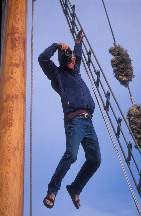
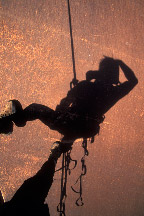
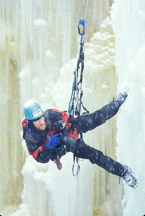
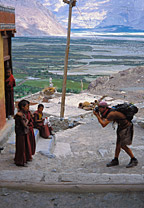
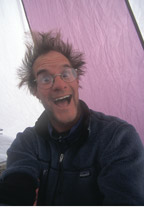
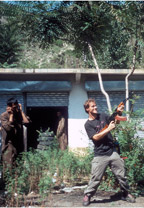

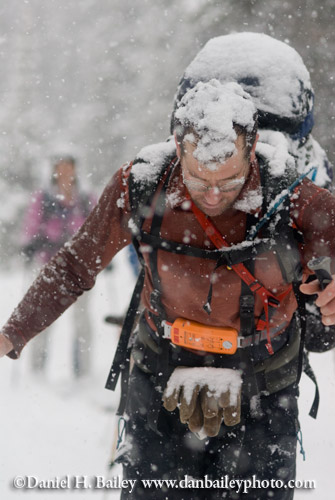
 (Skiers near Young’s Peak, Rogers Pass area, Selkirk Mountains, Canadian Rockies)
(Skiers near Young’s Peak, Rogers Pass area, Selkirk Mountains, Canadian Rockies)








